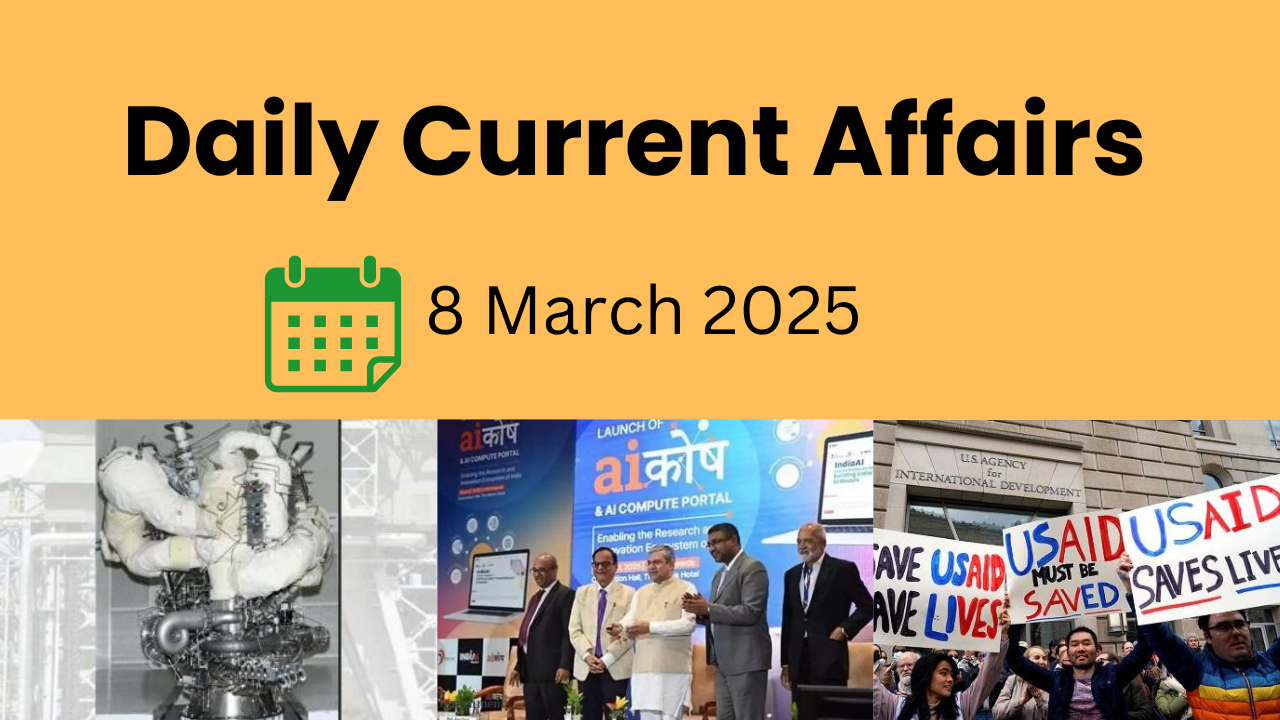1. ISRO Successfully Conducts Power Head Test for Semi-Cryogenic Engine
Context: The Indian Space Research Organisation (ISRO) has achieved a significant milestone by successfully conducting the Power Head Test Article (PHTA) for its SE2000 semi-cryogenic engine. This test is a crucial step in advancing India’s space propulsion technology.
Understanding the Power Head Test Article (PHTA):
Purpose of PHTA:
The PHTA serves to validate the integrated performance of essential subsystems, including:
- Gas Generator
- Turbo Pumps
- Pre-burner
- Control Components
Significance of PHTA:
This test is critical for the development of ISRO’s semi-cryogenic engine, ensuring reliability and efficiency in future space missions.
The Role of Cryogenic Stages in Space Launch Vehicles:
A cryogenic engine is the final stage of a launch vehicle, utilizing cryogenic fuels stored as liquids instead of gases. In space, where oxygen is absent, rockets carry their own oxidiser to support combustion.
What is Cryogenics?
Cryogenics involves the study of materials at extremely low temperatures (below -150°C) and utilizes cryogenic fluids such as:
- Liquid Nitrogen (LN2)
- Liquid Oxygen (LOX)
- Liquid Hydrogen (LH2)
Applications of Cryogenics:
Cryogenics has diverse applications across multiple fields, including:
- Space Exploration
- Medical Technology
- Food Preservation
- Industrial Gas Production
- Superconductivity
Semi-Cryogenic Engine: A Game-Changer:
Propellants Used:
- Utilizes Liquid Oxygen (LOX) and Kerosene, making it safer and less toxic compared to cryogenic engines that use liquid hydrogen.
Key Advantages:
- Higher Thrust: Delivers a powerful 2,000 kiloNewtons (kN) thrust.
- Increased Payload Capacity: Due to the lighter kerosene fuel, it enhances payload capability for launch vehicles.
Cryogenic vs. Semi-Cryogenic Engines: Key Differences
| Feature | Cryogenic Engine | Semi-Cryogenic Engine |
| Propellants | LOX & LH2 | LOX & Kerosene |
| Storage Temperature | -253°C for LH2 | Kerosene stored at normal temperature |
| Thrust | Higher specific impulse, lower density | Higher density impulse, more thrust per volume |
| Complexity | Complex handling & storage | Easier to handle & store |
| Reusability | Lower potential | Higher potential due to simpler components |
Next-Generation Launch Vehicle (NGLV): Paving the Future:
ISRO is developing the Next Generation Launch Vehicle (NGLV), a human-rated rocket designed for future space missions, including Gaganyaan.
Key Features of NGLV:
- High Payload Capacity: Can carry up to 30 tons to Low Earth Orbit (LEO).
- Reusable First Stage: Enhances cost-efficiency and sustainability.
- Advanced Propulsion:
- First & Second Stages: Powered by LOX engines.
- Upper Stage: Equipped with a cryogenic engine.
Successful Recovery Tests:
ISRO has successfully demonstrated the recovery of the first stage of the NGLV, a crucial step towards developing a fully reusable launch system.
Conclusion:
The successful PHTA test for the semi-cryogenic engine marks a major leap forward in India’s space capabilities. With advancements in semi-cryogenic propulsion and reusable launch technology, ISRO is positioning itself for future deep-space exploration and human spaceflight missions.
2. Pashu Aushadhi Kendras: Affordable Veterinary Medicines Under LHDCP
Context: The government is set to establish ‘Pashu Aushadhi’ stores across India to offer affordable generic veterinary medicines. This initiative is a crucial part of the revised Livestock Health and Disease Control Programme (LHDCP), recently approved by the Union Cabinet led by PM Modi.
Inspired by the Success of Janaushadhi Kendras:
Janaushadhi Kendras: A Proven Model
The Pashu Aushadhi initiative is based on the successful model of Pradhan Mantri Bharatiya Janaushadhi Kendras (PMBJKs), which provide low-cost generic medicines for humans.
Current Reach of Janaushadhi Kendras:
- Over 10,300 PMBJKs operate across India under the Ministry of Chemicals and Fertilisers.
- Janaushadhi Diwas is observed on March 7.
Extending Benefits to Animal Healthcare:
While PMBJKs cater to human healthcare, Pashu Aushadhi Kendras will provide cost-effective, non-branded veterinary medicines to support farmers and livestock owners.
Enhancing Livestock Health Through LHDCP:
The Union Cabinet, chaired by PM Modi, has revised the Livestock Health and Disease Control Programme (LHDCP) to strengthen animal healthcare and disease prevention.
Key Components of LHDCP:
- National Animal Disease Control Programme (NADCP) – Focuses on eliminating major livestock diseases.
- Livestock Health & Disease Control (LH&DC) – Includes three sub-components:
- Critical Animal Disease Control Programme (CADCP) – Targets severe livestock diseases.
- Veterinary Hospital & Dispensary Strengthening (ESVHD-MVU) – Provides mobile veterinary services for doorstep animal healthcare.
- Assistance to States for Disease Control (ASCAD) – Supports state-level disease prevention initiatives.
- Pashu Aushadhi Kendras (New Component) – Enhances access to affordable veterinary medicines via PM-Kisan Samriddhi Kendras and Cooperative Societies.
Financial Allocation:
The total budget for LHDCP (2024-2026) is ₹3,880 crore, with ₹75 crore earmarked for Pashu Aushadhi Kendras to ensure availability of affordable veterinary medicines.
Impact and Benefits of LHDCP:
Key Objectives:
- Disease Prevention – Controls major diseases like Foot and Mouth Disease (FMD), Brucellosis, PPR, Classical Swine Fever, and Lumpy Skin Disease through vaccination and immunization.
- Enhanced Veterinary Infrastructure – Strengthens disease surveillance and mobile veterinary services.
- Economic and Social Growth –
- Increases livestock productivity
- Prevents financial losses for farmers
- Generates rural employment
- Encourages entrepreneurship in veterinary services
Significance of Pashu Aushadhi Kendras:
India’s Vast Livestock Population:
According to the 20th Livestock Census (2019), India has a livestock population of 535.78 million, including 302.79 million bovines (cattle, buffalo, mithun, and yak).
Challenges Posed by Livestock Diseases:
Common diseases such as Foot and Mouth Disease (FMD), Brucellosis, Peste des Petits Ruminants (PPR), Cerebrospinal Fluid (CSF), and Lumpy Skin Disease cause significant productivity losses.
Despite vaccination efforts, farmers still bear high out-of-pocket expenses on veterinary medicines, highlighting the need for affordable alternatives like Pashu Aushadhi Kendras.
Integrating Traditional Veterinary Medicine:
Ethnoveterinary Practices at Pashu Aushadhi Kendras
Apart from generic medicines, Pashu Aushadhi Kendras will offer ethnoveterinary remedies rooted in traditional knowledge for treating livestock ailments.
Compilation of Indigenous Treatments:
The National Dairy Development Board (NDDB) has documented traditional herbal formulations to treat conditions such as:
- Mastitis
- Foot and Mouth Disease (FMD) – Treats mouth and foot lesions
- Fever & Diarrhoea in livestock
Key Ingredients in Ethnoveterinary Medicine:
Natural formulations include:
oriander, Garlic, Bay Leaves, Pepper, Cumin, Turmeric, Chirata, Betel, Tulsi, Neem, Sweet Basil, Jaggery, and Onions
These ingredients have been traditionally used to treat infections, fever, and digestive issues in animals.
Conclusion: The launch of Pashu Aushadhi Kendras is a transformative step in India’s veterinary healthcare system, ensuring affordable and accessible medicines for livestock owners. By integrating modern medicine with traditional remedies, this initiative will boost livestock productivity, reduce economic losses, and enhance rural livelihoods.
3. USAID Funding Cuts in India: Impact on Health, 5G, and Development Initiatives
Context: US President Donald Trump announced the implementation of reciprocal tariffs on trade partners starting April 2, regardless of their economic status. In his Joint Address to Congress, he criticized both friendly and unfriendly nations, including India, China, and the European Union, for imposing higher tariffs on US products. Trump highlighted India’s over 100% auto tariffs and claimed that countries like China and South Korea impose significantly higher duties compared to the US. He argued that these disparities have persisted for decades, despite US military and economic support to some of these nations.
Current Status of Trade Between India and USA:
As per U.S. estimates, the U.S. total goods trade with India was an estimated $129.2 billion in 2024.
- The U.S. goods exports to India in 2024 were $41.8 billion, up 3.4% ($1.4 billion) from 2023.
- U.S. goods imports from India totalled $87.4 billion in 2024, up 4.5% ($3.7 billion) from 2023.
- The U.S. goods trade deficit with India was $45.7 billion in 2024, a 5.4% increase ($2.4 billion) over 2023.
Uncertainty for India Amid US Tariff Plans:
US President Donald Trump reiterated his criticism of India’s high tariffs, particularly in the auto sector, where duties exceed 100%. His remarks signal that ongoing trade negotiations may not secure concessions for India, especially on reciprocal tariffs set to take effect from April 2.
Bilateral Trade Agreement at Risk:
India and the US are working on a bilateral trade agreement (BTA), with Indian officials seeking relief from tariffs, including the 25% duty on steel and aluminum. Commerce Minister Piyush Goyal is in the US to discuss the issue with United States Trade Representative (USTR) who is overseeing Trump’s tariff policies.
Concerns Over US Commitment to Trade Deals:
Trade experts warn that Trump’s tariff decisions, such as the 25% duties on Canada and Mexico, indicate a disregard for WTO norms and existing trade agreements. The imposition of these tariffs raises doubts about America’s adherence to future trade deals, including one with India.
The North American Free Trade Agreement (NAFTA), the trade deal between the US, Canada, and Mexico, had been in place since January 1994. However, Trump was dissatisfied with its terms and, during his first term, replaced it with the United States-Mexico-Canada Agreement (USMCA) in 2018-19. Trump’s tariffs on Canada and Mexico violate USMCA and highlight his disregard for negotiated trade agreements.
Farm Sector Vulnerability Amid US Tariff Plans:
India’s agricultural sector is highly vulnerable to US reciprocal tariffs due to significant differences in tariff rates between the two countries. Farmers’ unions continue to push for a legally guaranteed Minimum Support Price (MSP), adding to the sector’s sensitivity.
High Tariff Disparity Between India and the US:
According to an ICRIER report, India imposes an average tariff of 17% compared to 3.3% by the US. The gap is even wider in agriculture, where India’s simple average tariff is 39% and the trade-weighted rate is 65%, while the US maintains much lower rates of 5% and 4%, respectively.
Auto and Pharma Sectors Face Tariff Risks:
India’s automobile and pharmaceutical sectors, among its most successful industries, face potential setbacks due to US reciprocal tariffs. With countries demanding greater access to India’s protected markets, these industries may see higher costs and reduced competitiveness in the US.
Strategies for Indian Industries:
A GTRI report suggests that Indian firms should explore alternative export markets such as Europe, Southeast Asia, and Africa, where tariff barriers are lower. Additionally, forming joint ventures with American firms or setting up assembly units in the US could help mitigate the impact of tariffs.
US Challenges WTO’s Relevance and Policies:
The US 2025 Trade Policy Agenda, released on March 3, claims that the World Trade Organization (WTO) is losing its relevance and has deviated from its original purpose of promoting open, market-oriented trade.
The document criticizes the WTO’s Special and Differential Treatment (SDT) provisions, which allow developing countries like India to access benefits such as extended transition periods, higher tariff bindings, and subsidies. It argues that nations can claim SDT status by self-declaring as ‘developing,’ without objective criteria.
4. AI Kosha: India’s Secure AI Data Platform
Context: The Ministry of Electronics & Information Technology (MeitY) has launched AI Kosha, a secure AI datasets platform, along with the IndiaAI Compute Portal, to accelerate AI research and development in India.Announced on the IndiaAI Mission’s anniversary, this initiative aims to democratize AI access, enhance AI competency in governance, and support AI startups and researchers by providing seamless access to AI datasets and tools.
What is AI Kosha?
AI Kosha is a centralized and secure AI innovation platform designed to facilitate AI research and development in India. It provides access to high-quality datasets, AI models, and development tools, empowering researchers, startups, and enterprises to build cutting-edge AI solutions.
- Developed By: MeitY under the IndiaAI Mission
Key Features of AI Kosha:
AI Dataset Repository:
- Hosts 300+ datasets and 80+ AI models to accelerate AI research and development.
AI Sandbox Environment:
- Provides an integrated development environment (IDE) with essential tools and tutorials for AI model training.
Content Discoverability:
- Uses AI-readiness scoring to help researchers find the most relevant datasets.
Advanced Security & Access Control:
- Implements data encryption (both at rest and in motion) to ensure secure data handling.
- Offers API-based secure access and real-time malicious traffic filtering to protect data integrity.
Permission-Based Access:
- Features tiered access levels for researchers, startups, and government agencies, ensuring responsible data usage.
Benefits of AI Kosha:
Accelerates AI Research:
- Provides high-quality datasets and pre-trained models, reducing the time required for AI development.
Enhances AI Innovation:
- Enables startups, researchers, and enterprises to build real-world AI solutions efficiently.
Strengthens AI Security:
- Promotes ethically sourced, consent-based datasets, ensuring responsible AI development.
Boosts AI Adoption in Public Sector:
- Supports AI-driven applications in governance, healthcare, and education, improving public services.
Challenges & Limitations:
Limited Dataset Variety:
- Currently, most datasets are sourced from government and research institutions, limiting access to real-world commercial data.
Access Restrictions:
- Strict security protocols may create challenges for private-sector innovators seeking seamless data retrieval.
Early-Stage Development:
- AI Kosha is still evolving, requiring greater industry participation for wider expansion and adoption.
Conclusion:
With AI Kosha, India is taking a significant step towards building a robust AI ecosystem, fostering innovation, and ensuring secure and responsible AI development. As the platform evolves, collaboration between government, academia, and industry will be key to unlocking its full potential.
5. Protests Halt Basalt Mining in West Bengal
Context: The basalt mining activities at the Deocha-Pachami-Dewanganj-Harisingha (DPDH) coal project in Birbhum district, West Bengal, have been halted due to intense protests by local villagers. The opposition stems from concerns about environmental degradation and the impact on livelihoods.
Understanding Basalt Mining:
Basalt mining involves the extraction of basalt rock, a dense, durable volcanic stone used in various industrial applications. The primary method of extraction is quarrying, which involves digging deep trenches or pits to access basalt deposits.
Environmental Concerns:
Mining operations have several environmental implications, including:
- Air Pollution: Emissions from mining equipment, vehicular movement, and dust from unpaved roads contribute to poor air quality.
- Soil Degradation: Continuous quarrying affects soil fertility and landscape stability.
- Carbon Sequestration Potential: Interestingly, basalt naturally absorbs CO₂ from the atmosphere, locking it within its mineral structure. Using basalt in construction helps store CO₂ long-term, offsetting carbon emissions.
Key Applications of Basalt:
Due to its hardness and durability, basalt is widely used in various industries:
- Construction: Used in building blocks, tiles, and slabs.
- Agriculture: Crushed basalt acts as a natural fertilizer, rejuvenating weathered soils and enhancing plant growth.
- Infrastructure: Geogrid meshes made from basalt fibers reinforce roads, improving stability and extending road lifespan.
- Insulation: Basalt fibers serve as thermal and acoustic insulators, improving energy efficiency in buildings.
Major Basalt Zones and Mines in India:
- Deccan Traps: One of the largest volcanic provinces, covering most of west-central India.
- Deocha-Pachami Coal Block: India’s largest coal reserve, containing 12.31 billion tonnes of coal and basalt deposits.
- Rajmahal Basalts: Located in the Rajmahal Hills of Jharkhand, extending into the Bengal Basin.
- Bombay Area Basalts: Found in Mumbai, Salsette, and Trombay, belonging to the Upper Deccan Group.
The recent protests at Deocha-Pachami highlight the ongoing debate between economic development and environmental sustainability. The future of basalt mining in this region will depend on how authorities balance these concerns.
6. Could Europe’s Eutelsat Replace Starlink in Ukraine?
Context: Ukraine has been heavily reliant on Elon Musk’s Starlink satellite internet to maintain military communications after its traditional fixed-line and mobile networks suffered damage from Russian airstrikes. Starlink has also played a crucial role in ensuring civilian internet access across the country.
However, concerns over a potential loss of Starlink access have fueled discussions about alternative providers, with a strong focus on Eutelsat, a European competitor.
Eutelsat: A Viable Alternative?
- Who is Eutelsat?
Eutelsat, a Franco-British satellite company, has been providing satellite communication services in Ukraine. After merging with OneWeb in 2023, it became the only other operator with an active Low Earth Orbit (LEO) satellite constellation, apart from Starlink.
- Network Capabilities:
- Eutelsat operates around 630 LEO satellites, complemented by 35 geostationary satellites.
- While Starlink offers speeds up to 200 Mbps, Eutelsat provides speeds of 150 Mbps.
- Eutelsat’s services are more expensive, with terminals costing up to $10,000, compared to Starlink’s $589, and monthly plans ranging from $95 to $440.
Other Satellite Internet Alternatives:
- SES (Luxembourg):
- SES provides services through its O3b mPOWER constellation in Medium Earth Orbit (MEO).
- While mainly catering to corporate, government, and military clients, it does not offer direct-to-consumer services like Starlink and Eutelsat.
With growing geopolitical tensions, the future of Ukraine’s satellite connectivity remains uncertain, making Eutelsat a potential, yet costlier, alternative to Starlink.
ASI’s Underwater Exploration Off Dwarka Coast:
Project Overview:
The Archaeological Survey of India (ASI) has launched a fresh phase of underwater exploration off the Dwarka coast in Gujarat to uncover and safeguard India’s submerged cultural heritage. The Ministry of Culture officially announced the initiative.
Expert Team Leading the Mission:
A team of five archaeologists is conducting the survey near Gomati Creek under the leadership of:
- Prof. Alok Tripathi – Additional Director-General (Archaeology)
- H.K. Nayak – Director (Excavations and Explorations)
- Dr. Aparajita Sharma – Assistant Superintending Archaeologist
- Poonam Vind and Rajkumari Barbina
This marks a historic first with significant participation of women archaeologists in an ASI-led underwater mission.
Renewed Focus on Underwater Archaeology:
- The project is part of the revived Underwater Archaeology Wing (UAW) of ASI, dedicated to offshore surveys and underwater excavations in Dwarka and Bet Dwarka.
- Since the 1980s, the UAW has led several key explorations, including:
- Bangaram Island (Lakshadweep)
- Mahabalipuram (Tamil Nadu)
- Loktak Lake (Manipur)
- Elephanta Island (Maharashtra)
Collaborations and Previous Discoveries:
- ASI has worked closely with the Indian Navy and other research organizations to protect submerged heritage sites.
- Between 2005 and 2007, ASI’s offshore excavations in Dwarka uncovered stone sculptures and anchors, laying the groundwork for further exploration.
Preserving India’s Submerged Legacy:
The ongoing underwater investigations are crucial in understanding ancient structures submerged along the Dwarka coastline. The findings from this research could offer valuable insights into India’s rich maritime history and cultural heritage.




